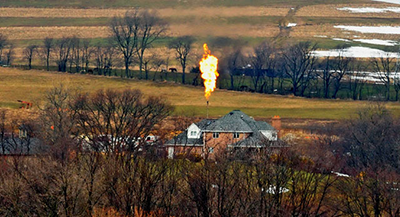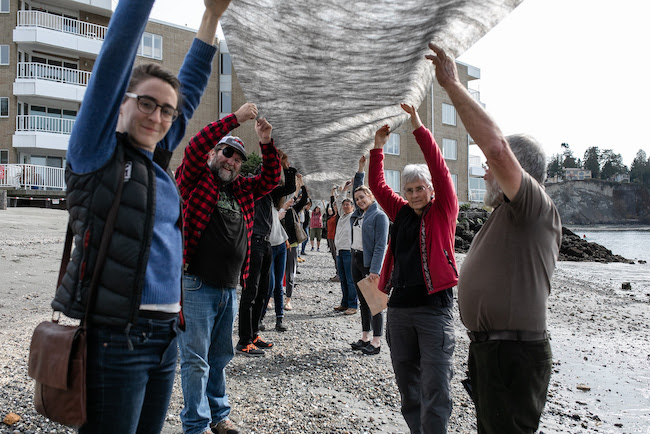ALERT takes new legal action with the EPA
| It’s said that maritime law is written in blood or oil—after disasters rather than before them. The same can be said of our nation’s emergency oil and chemical disaster response plan, the National Contingency Plan (NCP or the Plan).Our campaign to ban toxic dispersants from use during oil spill response started after the Exxon Valdez disaster 30 years ago. One of the products authorized for use then, Inipol EAP 90, caused blood in urine on skin contact—which usually occurred when the product dissolved O-rings in spray backpacks and workers’ rain gear. The consequences were lethal for crews that sprayed Inipol on beaches. And so Inipol was quietly discontinued by its manufacturer in 2005.
However, other products authorized for use during oil spill response, like Corexit EC 9527A, contain the same toxic solvent, 2-butoxyethanol (2-BTE), that was in Inipol. The Corexit manufacturer even warns that the product is “toxic to aquatic life” and “Do not allow contact with… surface… water,” meaning the water at the surface of oceans, lakes, rivers, etc. Yet the Environmental Protection Agency (EPA) authorizes use of such products during oil spill response. In fact, the most recent change to the NCP rules in 1994 provide for expedited and preauthorized use of dispersants. That was government and industry’s response to anticipate and bypass public opposition to dispersant use during future spills—a public relation ‘lesson learned’ from the Exxon Valdez disaster. Photo Credit: Wikimedia Commons During the 2010 BP Deepwater Horizon (DWH) oil disaster response, some two million gallons of Corexit 9527 and another toxic dispersant, Corexit EC 9500A, were used at the ocean surface and subsurface at the broken riser with predictably disastrous consequences for humans and wildlife. In yet another chapter of oil and blood, there is opportunity for change. Corexit dispersants are toxic and detrimental to people’s health and the environment. Read our simple factsheet = Dispersants: Myths and Facts * * * * * * * * * * In 2015, the EPA invited and received over 81,000 public comments during its proposed rulemaking to the NCP’s rules governing dispersant use—the majority of which called for reducing and restricting use of toxic dispersants. We rallied and made our voices heard. Since then, EPA has done nothing. That is why ALERT and other petitioners, represented by the Berkeley Environmental Law Clinic, filed a 60-day notice of intent to sue the EPA (The Guardian feature article) on March 25, 2019, to commemorate the 30th memorial of the Exxon Valdez. There has been enough blood and oil lost over this. EPA has failed its nondiscretionary duty, mandated under the Clean Water Act, to update the NCP in response to significant advances in the understanding of long-term harm from oil spills, as well as in the risks and effectiveness of dispersants, to humans and wildlife. And we’re calling them on it! By not keeping current with the science, the 1994 Plan endangers the lives (The Washington Post feature article) of oil spill response workers, coastal residents, and sea life from the ocean surface to the ocean floor during future spills. And EPA’s failure to conclude the 2015 rulemaking process by issuing a final rule also puts at risk the 133 million or so Americans who live near the coasts – 39 percent of the U.S. population.
Furthermore, it is not just coastal residents who are in harm’s way of the next ‘big one.’ The millions of us who live near lakes, rivers, or along oil pipeline corridors are also at risk because the 1994 NCP rules allow the use of dispersants in freshwater spills, despite the fact that dispersant effectiveness is minimal in freshwater environments. IMAGINE what could happen: Just like in 2015 when the BP Whiting Refinery oil spill endangered the drinking water of nine million people, EPA could authorize dispersant use in Lake Michigan in future spills. * * * * * * * * * * And so ALERT and the other petitioners have set in motion a series of events—both legal and local. During the next couple months as we wait to file the lawsuit, we will be posting calls for action to support this case. It’s time for cities and local groups to weigh in on this— and that’s where you can help!
Caption: Riki Ott commemorates the 30th Memorial of Exxon Valdez oil spill in solidarity with Heiltsuk First Nation sovereighnty lawsuit, March 24, 2019. Photo by Elizabeth Krawczak Your community can demand action at the local level to revoke preauthorization of deadly dispersants in local Area Contingency Plans. Alternatively, your community can let EPA know that you support our effort to finalize the 2015 rule governing dispersant use. We CAN voice our concerns, hold governments accountable and make change. Get started by educating yourself with the new resources on our website and articles below. Then talk to your neighbors and local emergency disaster preparation people. Together we CAN protect our waters, wildlife and families from further harm during oil spill disasters. Look out for our updates and Calls to Action soon! In solidarity, Dr. Riki Ott ALERT project director * * * * * * * * * * TAKE ACTION NOW READ AND SHARE ALERT’s Press Release about notice of intent to sue the EPA gets featured in the news. March 26, 2019 The Guardian feature article March 26, 2019 The Washington Post feature article |



